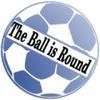 We rarely get excited about things these days. Well, apart from a trip to a new ground, a new city or even a new country. But the opening of the new Museum of Football in Manchester was one thing we have been looking forward to for a couple of years, even more so as a couple of our pictures are being featured in one of the exhibits. Unfortunately work (yes, we do have to put some work in around the football matches) meant we couldn’t attend the preview of the museum, but we knew a girl who could. So we dispatched “our girl up north”, Christa Norman along to find out what the museum is like:-
We rarely get excited about things these days. Well, apart from a trip to a new ground, a new city or even a new country. But the opening of the new Museum of Football in Manchester was one thing we have been looking forward to for a couple of years, even more so as a couple of our pictures are being featured in one of the exhibits. Unfortunately work (yes, we do have to put some work in around the football matches) meant we couldn’t attend the preview of the museum, but we knew a girl who could. So we dispatched “our girl up north”, Christa Norman along to find out what the museum is like:-
A rare sunny day in Manchester and I had high hopes for the new National Football Museum which opened today. The National Football Museum, now housed in the entire Urbis building opened its terraces to football enthusiasts from around the country.
Some of the highlights include; the 1966 World Cup Final Ball, the shirt worn by Maradona during the infamous ‘Hand of God’ quarter finals match between England and Argentina,

I grabbed some extra time with Kevin Moore, the National Football Museum Director to find out what the museum is all about.
“I was watching one of the museum videos yesterday and it says that that it is the biggest and best football museum in the world, what makes it that?”
“Wonderful, iconic building that we’re in, in the heart of the city centre, this Urbis building, the museum is the whole of the Urbis building, but it’s the collections, it is the world’s biggest and best football collections. We’ve got the collections of the FA, the football league, the FIFA collection which we own, material on loan from display from FIFA, 140,000 items. It’s just an extraordinary collection, mainly about the history of the game in England but also around the world.”
“What’s your favorite piece in the museum?”
“Well, for me, I mean there’s so many, there’s 2500 actually on display, like most museums most is behind the scenes, it’s actually stored at our research and collection center in Preston. You go to any museum, you don’t see most of it, so it gives us a chance to change things around.

Plus it’s always been one of the most popular items in the museum and it goes on tour. It kind of has a life of its own. I’ve taken it to Cologne during the World Cup in 2006 and it had its own seat on Eurostar.”
“Was it first class?”
“It was indeed – paid for by Eurostar.”
“If there was a piece you could have in the museum that you don’t have your hands on, what would it be?”
“You’re going to think my answer is tripe but we’ve got 140,000 items, it is a question of what haven’t we got? We would like more about the history of women’s football, our collection is smaller and it’s a hidden history and that’s partly because historians and ourselves, we’ve been looking since we set the museum up, but it’s a hidden history and now it is being explored. Because it was banned in England from 1921-1970 it was kind of underground and therefore little has survived, so now we’d really like to improve our collections.
We do have some wonderful items related to women’s football here and in our Hall of Fame since we launched it in 2002 women have always been central to that.”
“Why Manchester? Why is it in Manchester and not London?”

“Where do you see the museum heading in the next 5 years?”
“It won’t stand still of course, we are very proud of what we have done. We’re always seeking to improve what we do. What will happen when we open the museum is that lots of material will come to light. I’ve had offers of objects this morning from people, everybody who is into the game has memorabilia, has memories, and it’s very important we get the stories with it. Because the object on its own, it needs that person’s story with it for it to be interesting. We haven’t got an object on display here that doesn’t have a story to go with it. If it’s got no story it’s not on display. It has to be a people’s story.
Let’s see which are the most popular parts and develop them, but yeah we won’t stand still, of course and then we’re going to develop our Preston site as our research and collection center. The collections keep growing and keep growing and there are a lot of people doing research on football, history and culture now. We have researchers coming from all over the world, we have three from Australia this year. They have to come here because they want to do the research and the collections are not digitised.”
You can see more of Christa’s pictures here.
The museum opened its doors to the public today at Urbis in Manchester. More details can be found here.

